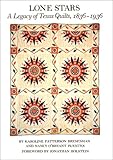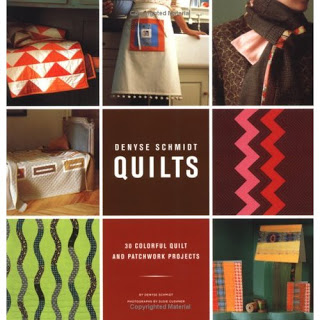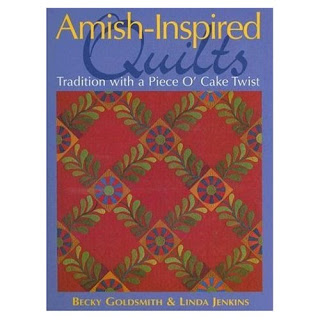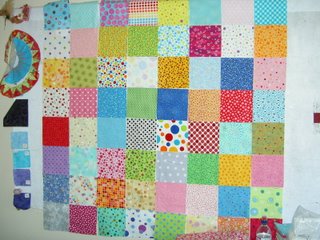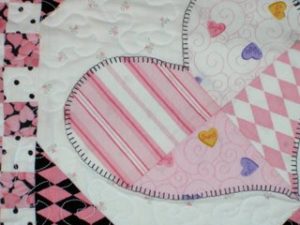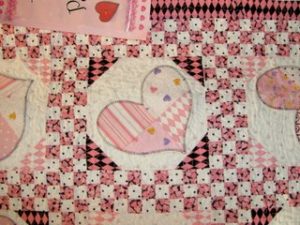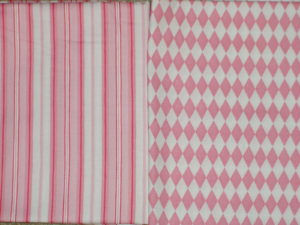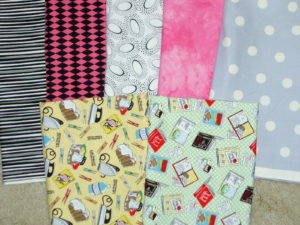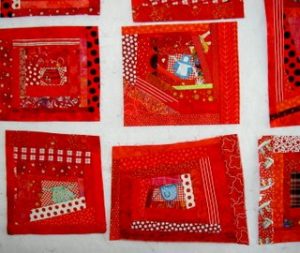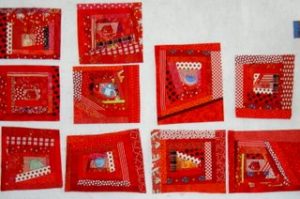At the drugstore, I happened upon BH&G’s Spring 2006 issue of Quilts and More. I had never seen this magazine before and was immediately drawn to the quilt on the cover. There should be no suprise that this quilt was made with dot fabrics. The block is called, according to the magazine, at least, Dolly Madison Star. I haven’t looked it up in resources I consider to be more reliable, so I can’t say at the moment. I tried to find a picture of the quilt on the web, but the BH&G people don’t have it on their website so you’ll have to trust me that it is a seriously cool quilt. Excellent use of many dot fabrics. I would actually consider making a quilt similar to this, because it is the perfect quilt for a grey, wet and cold winter in a life-sucking beige house.
Dots are definitely on the mind, but so are some new books that I have bought or received as gifts.
In general I don’t like books that are mostly patterns. I like books with lots of great pictures that depict quilts that show me something new and inspire me to think outside of the box.
The Modern Quilt is a pattern book, but the designs are innovative and fun. They are supplemented by smaller pictures showing different colorways. There are bits about putting together colors. The best part is that the authors (and publishers, I suppose) had the guts to include patterns with curves and other odd shaped pieces. This tells me that they are not condescending to the lowest common quilting denominator. YAY!!! Some of the piecing reminds me of Ruth McDowell’s Piecing book.
Ruth McDowell’s Fabric Journey is another recent acquisition. She is, without a doubt, my favorite quiltmaker. Jane Sassaman and Judy Martin run a close second, but I love Ms. McDowell’s nearly exclusive use of piecing and her nearly exclusive use of commercial fabrics. She really teaches, and demonstrates in her quilts, the extraordinary things that a quiltmaker can do with piecing and celebrates good technique. Fabric Journey gives insight into several of Ms. McDowell’s quilts. Ms. McDowell discusses several of her quilts, the inspiration, the use of fabric and various piecing techniques. This is not a pattern quilt per se, but the reader can use the descriptions to create their own designs. Again, Ms. McDowll does not condescend to the reader. She gives the impression of assuming that, with practice, anyone can piece the way she does.
Whimsical Quilts by Carol Burniston was a total impulse buy at Thimble Creek. The reason I bought it was because it had a great and fun pattern for appliqued flamingos. You never know when you might need a pattern for flamingos, right? It is a pattern book, but it does have fun colors and lots of good photos. The other quilt I like in the book is called, oddly enough, Hot Tamale Sunflowers. There is also a fun sheep quilt that I would never make, but it is cute. The books also includes a fish qult with a lot of possibilities. The book makes me smile, so it was worth the price.
With my birthday money from RBL, I bought Mary Schafer American Quilt Maker by Gwen Marston. I have a number of Marston’s books and really enjoyed the workshop on Libertated Quiltmaking I took from her a few years ago. The quilt I made as a result of the techniques I learned in the class can be seen on Artquiltmaker.com. The Mary Schafer book has nothing to do with Liberated Quiltmaking, however. It is a history type quilt book depicting the work and collections of Mary Schafer. The quilts are classic in style, though many of them have a twist, such as Grandmother’s Pride, 1980, pg. 111. I also like the pictures of Schafer’s templates, patterns, family photos as well as the numerous color photos of quilts scattered throughout the book.
For my birthday, JZS was kind enough to buy me Textile Designs from Thames and Hudson, which has been on my Amazon list for an eternity. This is a book that shows the history of textlie designs for the past 200 years. It is great to look at the variety of patterns through 200 years. I particularly like some of the futuristic patterns, such as those in the Geometric section on page 199 and those on page 185 and 186. It occured to me that, if I found the perfect pattern on one of the pages, I could scan and print it to fabric for personal use only, of course. Fabric designers should look at some of the 20th century designs in this book recolor and reprint them. Pattern designers seem to focus on the Civil War type colors and patterns at the moment and those are just too boring (in design) and too depressing (in colorways) for me.
Index to the Laura Wheeler Quilt Blocks is one of a series of indexes that Rose Alboum from West Halifax, Vermont is putting together. This index is one of the ‘block dictionary’ type books that I love. It has the name, number and a sketch of all the blocks designed by Laura Wheeler. There are no templates or patterns, but the blocks could easily be designed in EQ5 or by some other pattern design method (e.g. normal drafting). Perhaps Ms. Alboum will cut a deal with The Electric Company and EQ will issue ancilliary CDs with these patterns on them! Again, it is great to see the old patterns because they have odd shaped pattern pieces. I look forward to seeing more of Ms. Alboum’s work.
Another impulse book buy, while I was in Seattle in January, was Paper Piecing Picnic by the editors and contributors of the QNM and Quiltmaker magazine. Again this is a pattern book, but there are some nice photos, especially of Indian Wedding Ring, page 72, Dandelion, page 67, Trip to New York, page 63, and Fireworks, page 43. I also like the row quilt layout of Sunflowers, page 52, but am not so excited about the square-ness of the actual sunflowers. Also the mathematical relationship of the center to the petals seems a bit off to me, but it could be the photo in the book. The photos in this book are clear and there are many of them. The instructions, if you like paper piecing seem to be easy to understand. I also like the bright colors.
B&B sent me Kaffe Fassett’s Museum Quilts, also for my birthday (what a bonanza this year! WooHoo!!!). For Fassett, it is all about the fabric and I love the many fabrics that he uses and the combinations that he comes up with. The designs/patterns have the feeling of classic quilts, but the fabrics and details make them fresh and new. I also love it that he is not afraid to mix color and pattern. There is always more fabric, so why be concerned that patterns might clash? I like the way a number of the quilts reflect mosaic floors. Unfortunately, the publisher seems to have required the ubiquitous “how to make a quilt” section. I don’t know why publishers just don’t refer to some other more complete book on quiltmaking rather than forcing authors to waste 30-50 perfectly good pages on an inadequate section on how to make a quilt. Not that the directions in this book are poor, but making an entire quilt, no matter how good the directions, cannot, IMO, be explained in 30-50 pages. The space would have been better used for a few more quilts or a gallery section.
I admire Sally Collins precision work a lot and her latest book is another that I purchased with birthday money. It is called Borders, Bindings & Edges. First, there are excellent pictures of Collins’ quilts, but include other artist’s work as well. This is a book about techniques. Collins believes that precision piecing is important and this book thoroughly explains how create different types of borders, including mitered corners. She also discusses bindings (thus the title) and has lengthy discussions on different types of finishing. If you want to improve your technique, I would recommend this book, as well as one of previous books, The Art of Machine Piecing: How to Achieve Quality Workmanship Through a Colorful Journey and Small-Scale Quiltmaking: Precision, Proportion, and Detail.
Quilt Visions 2004 is a catalog of the Visions show, held in San Diego every other year. This is my perfect book, in many ways: no patterns! I like Cacti I by Nancy Cordry, Autumn Splendor by Nelda Warkentin and Weavings 12 by Marie Castle Wing, but am annoyed by the ‘quilts’ that look like photographs. I could discuss the “is it a real quilt” issue with people for years, but the bottom line for me is that if there is no piecing or applique, then it is tending to not be a real quilt. This, of course, begs the question of wholecloth quilts, but perhaps they are not quilts either? For photographic reproduction ‘quilts’, I just don’t see the point. Take a photo and move on, IMO. This book comes with a CD, which I haven’t had the chance to review yet. I like the trend towards including CDs with books and guilds creating CDs of their shows. It makes the shows less ephemoral to me.
AJA gave me Art Quilts: A Celebration for Christmas. Again, this book has no patterns or project sheets. It is a catalog of 400 art quilts from 1995-2003 arranged by year. I love it! First, I am happy that they are not telling me how to make these quilts. Second, I love the organization. Someone (a librarian, maybe??) got the publisher to organize the quilts in a way that makes sense. This organization makes it easy to see how art quilts have evolved. Third, I like the selection of quilts chosen. I can appreciate the wide variety of techniques, including photograph type quilts, when there are a wide variety of techniques shown and you can see the photos in context. I hope the publisher does well enough with this edition to do future updates of this book. Buy Art Quilts: A Celebration to show support!
Karen K. Stone’s book Quilts was one I bought when I bought the companion software from the Electric Quilt Company last year. It is a pattern book, but there are a few photos that show her inspiration and the close-ups of the blocks are so good that it makes the pattern part worth it. Her fabric combinations remind me of Kaffe Fassett’s.
Judy Martin is one of my favorite block designers. She is prolific, supports herself with her own business and doesn’t condescend to her readers. Sense a trend here? The blocks she designs are classic with a twist. She also seems to want people to try out odd shapes and teaches how to create them. Her book, Knockout Blocks and Sampler Quilts has an amazing number of new block designs and quilt layouts to try. It is, however, a bit of a disappointment. Note: definitely still worth purchasing! The designs are great, extremely creative and fresh, but there are no actual fabric quilts shown in the book. It looks like all the quilts pictured are computer generated. I can appreciate the speed with which one can create computer generated designs and, thus, produce a book, but I want to see actual fabric quilts made with the patterns. I would love to see an update of this book, or a companion book with actual fabric quilts shown. I bet Judy could find fans to create blocks and quilts that could be used in the updated version of the book, if she doesn’t have time to do all the sewing. I’ll sign up for a block or two! If you like blocks, this book is still a wonderful resource.
Cookies and Quilts is also a Judy Martin book which combines quilt patterns with decadent chocolate recipes. This book has lots of photos of quilts. Not all of them are star quilts. It is primarly a pattern book and there are no sections with blocks only. I haven’t tried any of the cookie recipes, but the photos of the cookies look delicious.
 Old Maid’s Puzzle: A Quilting Mystery by Terri Thayer
Old Maid’s Puzzle: A Quilting Mystery by Terri Thayer